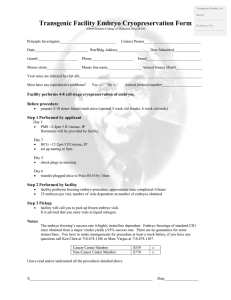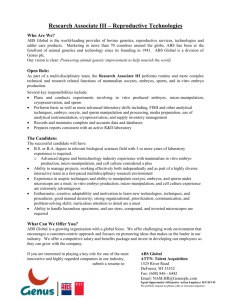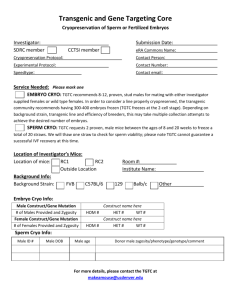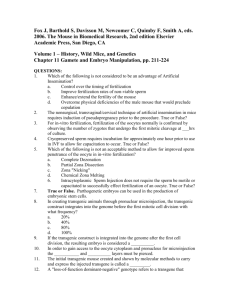IACUC Protocol #: Approval Date: UNIVERSITY OF COLORADO DENVER
advertisement
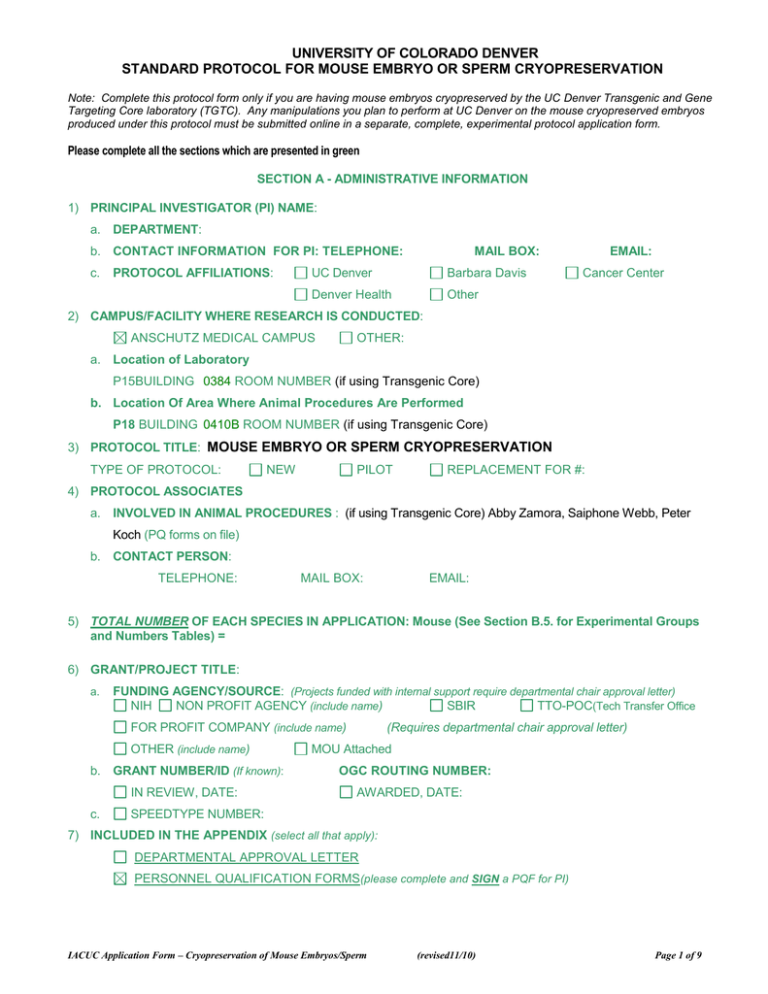
UNIVERSITY OF COLORADO DENVER STANDARD PROTOCOL FOR MOUSE EMBRYO OR SPERM CRYOPRESERVATION Note: Complete this protocol form only if you are having mouse embryos cryopreserved by the UC Denver Transgenic and Gene Targeting Core laboratory (TGTC). Any manipulations you plan to perform at UC Denver on the mouse cryopreserved embryos produced under this protocol must be submitted online in a separate, complete, experimental protocol application form. Please complete all the sections which are presented in green SECTION A - ADMINISTRATIVE INFORMATION 1) PRINCIPAL INVESTIGATOR (PI) NAME: a. DEPARTMENT: b. CONTACT INFORMATION FOR PI: TELEPHONE: c. PROTOCOL AFFILIATIONS: MAIL BOX: UC Denver Barbara Davis Denver Health Other EMAIL: Cancer Center 2) CAMPUS/FACILITY WHERE RESEARCH IS CONDUCTED: ANSCHUTZ MEDICAL CAMPUS OTHER: a. Location of Laboratory P15BUILDING 0384 ROOM NUMBER (if using Transgenic Core) b. Location Of Area Where Animal Procedures Are Performed P18 BUILDING 0410B ROOM NUMBER (if using Transgenic Core) 3) PROTOCOL TITLE: MOUSE EMBRYO OR SPERM CRYOPRESERVATION TYPE OF PROTOCOL: NEW PILOT REPLACEMENT FOR #: 4) PROTOCOL ASSOCIATES a. INVOLVED IN ANIMAL PROCEDURES : (if using Transgenic Core) Abby Zamora, Saiphone Webb, Peter Koch (PQ forms on file) b. CONTACT PERSON: TELEPHONE: MAIL BOX: EMAIL: 5) TOTAL NUMBER OF EACH SPECIES IN APPLICATION: Mouse (See Section B.5. for Experimental Groups and Numbers Tables) = 6) GRANT/PROJECT TITLE: a. FUNDING AGENCY/SOURCE: (Projects funded with internal support require departmental chair approval letter) NIH NON PROFIT AGENCY (include name) SBIR TTO-POC(Tech Transfer Office FOR PROFIT COMPANY (include name) OTHER (include name) b. GRANT NUMBER/ID (If known): IN REVIEW, DATE: c. (Requires departmental chair approval letter) MOU Attached OGC ROUTING NUMBER: AWARDED, DATE: SPEEDTYPE NUMBER: 7) INCLUDED IN THE APPENDIX (select all that apply): DEPARTMENTAL APPROVAL LETTER PERSONNEL QUALIFICATION FORMS(please complete and SIGN a PQF for PI) IACUC Application Form – Cryopreservation of Mouse Embryos/Sperm (revised11/10) Page 1 of 9 SECTION A2 – INDIVIDUAL INVESTIGATOR SPECIFIC PROJECT INFORMATION 1, What will be cryopreserved? (check only one.) a. Embryos b. Sperm 2. What specific strain(s) and/or transgenic line(s) will be cryopreserved? 3. Why is the line(s) being cryopreserved? 4. POTENTIAL CONTRIBUTION(S) TO BIOLOGY AND/OR HUMAN MEDICINE: These procedures may help produce more rapid and accurate accumulations of experimental results which may benefit development of new medicines and may contribute to elucidation of the biochemical processes of living organisms. (Please add a statement of the potential contribution to biology and/or human medicine for your particular line(s)) 5. What is the initial source of the animals? Transferred from another protocol (provide #): Captured from wild. Donated. Source donor is: Other. Please specify: 6. Where (in which laboratory) will the cryopreserved gametes be stored? a. TGTC (default) b. Other location IACUC Application Form – Cryopreservation of Mouse Embryos/Sperm (revised11/10) Page 2 of 9 SECTION B - PROJECT DESCRIPTION 1. PROJECT GOALS IN NON-SCIENTIFIC (i.e. “LAY”) LANGUAGE The goal of this study is cryopreservation either embryos or sperm from valuable animal strains. This technique provides long-term storage and preservation of live embryos or sperm of valuable animal strains. This technique provides continuity and assures recovery of valuable strains or lines of animals in case of losses or other colony difficulties. (Individual Investigators must provide specific information about their strain or line in section A2) 2. NARRATIVE DESCRIPTION OF ANIMAL PROCEDURES: A. Embryo Production for Cryopreservation: 1. 2. Non-transgenic embryo donors obtained from vendor: a. Non-transgenic embryo donors are used when the resultant embryos are not required to be homozygous or are preferred to be non-homozygous. Some homozygous genes result in lethality. This method is very expedient. b. The Investigator must make available in their room, a minimum of six to ten sexually mature stud males of the selected strain or transgenic line from their colonies for the use of the Transgenic and Gene Targeting Core laboratory (TGTC). The TGTC will purchase an equal number of non-transgenic (wild-type) embryo donor females of the same strain. c. The TGTC will superovulate the embryo donor females by IP (intraperitoneal) injection of PMSG (pregnant mares' serum gonadotropins) followed by IP injection of hCG (human chorionic gonadotropins) at 44-48 hours later. The embryo donor females are picked from the TGTC by the Investigator’s lab personnel then who mate them with their transgenic stud males. d. The next morning, the Investigator’s lab personnel separate the donor females and deliver then to the TGTC before 10AM. The TGTC will euthanize the donors by C02 narcosis (followed by cervical dislocation) and the embryos are collected from the oviducts, cleaned and cryopreserved Embryo donors obtained from the investigator-supplied females: a. Background strain considerations or genetic background may dictate that this method be used. Many times, the investigator is the sole source of the particular strain or genetically altered animals to be cryopreserved. The use of transgenic embryo donors is necessary to preserve these vital traits and to maximize production of as many homozygous embryos as possible. b. In order to produce the transgenic embryo donors, the investigator will mate three sexually mature transgenic stud males with the same number of sexually mature transgenic females of the same line. The litters produced by these mating will provide the transgenic donor females required this procedure. c. At ten days following mating, the females and males are separated and the females housed separately and allowed to give birth. Male pups in the litter are culled at approximately one week of age leaving only the female pups. This strategy should produce at least six female transgenic pups. d. At 21 days of age, the female pups are superovulated as described above and the embryos collected as described previously and mated to each of the available transgenic stud males. e. After mating, the embryo donors can be group housed and delivered to the TGTC before 10AM by the Investigator’s lab personnel. The embryos are harvested as described in section 2A-1d 3. Cryopreserve Embryos Embryos are washed in five changes of embryo culture medium, transferred to IACUC Application Form – Cryopreservation of Mouse Embryos/Sperm (revised11/10) Page 3 of 9 cryopreservation medium and frozen. B. Collect Sperm for Cryopreservation From Transgenic Males a. b. c. d. e. The investigator must supply at least two young, breeding age stud males from their colony. The males will be transferred to the TGTC. The males are euthanized and the testes and epididymi quickly removed. The adhering blood and tissue is removed and washed free of excess blood and tissue. The testes and the epididymi are placed into pre-warmed sperm cryoprotectant media and the sperm is allowed to swim out into the media for a short period of time. The sperm suspension is then quickly loaded into straws and cryopreserved. 3. STUDY END-POINT FOR ANIMALS (Select all that apply) a. Animals will not be euthanized at study completion. Breeder males.(embryo cryopreservation only) b. Animals will be euthanized: without significant treatments or experimental procedures.. after defined period of time: embryo donors at 3-4 weeks (embryo collection – embryo cryopreservation) and sperm donors (sperm cryopreservation) 4. ANIMAL IDENTIFICATION: A. Species: Mouse B. Strain (for rodents): as in section A 2.1 C. Sex: male/female D. Age and/or weight range: 3 weeks – 1 year 5. EXPERIMENTAL GROUPS AND NUMBERS: Stress Category C a. Table A: Embryo Cryopreservation (sections 2A-1 and 2A-2) Experimental/Control Group Names 2A1a-d Embryo donors from strain to be cryopreserved (embryo cryo only) (vendor supplied) 2A2a-e Embryo donors from strain to be cryopreserved (embryo cryo only) Investigator supplied) Transgenic Breeder males (embryo cryo only ) (Investigator supplied) Number of Animals per Number of Repetitions Group (per group) 10 2 10 2 Up to 10 2 Total number used in group (sum per row) 20 Do not use this entry if embryo donors are being produced by the investigator. 20 Do not use this entry if embryo donors are purchased from vendor. 20 Use this number for mating for females obtained from either embryo donor source The animals used for each group are the Transgenic Breeder males and either Embryo donors from 2A1 – vendor supplied donors OR FROM 2A2 – investigator supplied transgenic donors from their colony. b. Number of animals required for the entire embryo cryopreservation study: 40 x # lines = c. How was the number of animals in each group determined? IACUC Application Form – Cryopreservation of Mouse Embryos/Sperm (revised11/10) Page 4 of 9 Each group represents the number of animals required to produce sufficient embryos necessary for successful cryopreservation. See following notes: i. Embryo donors will either be ordered from vendors or produced by matings with two or more of the males provided by Investigator. The exact source of the donors depends upon the requirements of the Investigator's transgenic mouse line and strain. ii. Transgenic females may be required to produce litters from which to draw up to ten 21-day old donor females. iii. In either of the above (i and ii) schemes for obtaining the embryo donors, up to ten males from Investigator's colony of transgenic animals will be used to mate with the embryo donors. iv. The estimated number of males used represents the maximum number of males supplied by the investigator to produce embryos via breeding them to vendor supplied donors or females produced within the investigator’s colony d. How was the number of repetitions for each group determined? Occasionally, the embryo donors (either vendor-supplied or investigator-supplied) produce insufficient numbers of fertile embryos for effective cryopreservation. In this case, the procedure may have to be repeated. e. Table B: Sperm Cryopreservation Experimental/Control Group Names Number of Animals per Number of Repetitions Group (per group) 2Ba-e Sperm Donor males (Investigator supplied) Up to 2 Total number used in group (sum per row) 4 2 f. Number of animals required for the entire embryo cryopreservation study: 4 x # lines = g. How was the number of animals in each group determined? Only male mice are used in this section of the study. Although one male should provide sufficient sperm for cryopreservation, it is advisable to use at least two be used to increase genetic variability and in the event that one male produces low numbers or quality of sperm. EXPERIMENTAL AGENTS: Embryo Cryopreservation only. Experimental Agents Frequency of Duration of Treatment Dosing Effect Dose Route) Volume PMSG 2.5-5 IU IP 0.1cc 1 48 hour hCG 2.5-5 IU IP 0.1cc 1 24 hr 7. 8. NEUROMUSCULAR BLOCKING AGENTS (I.E., PARALYTICS): N/A HAZARDOUS MATERIAL USE: PMSG and hCG SECTION C - ANESTHESIA AND ANALGESIA 1. PRE-ANESTHETIC/ANALGESIC OR SEDATIVE DRUGS: N/A a. DRUG ANESTHETIC DRUGS : INITIAL DOSE SUPPLIMENTAL DOSE IACUC Application Form – Cryopreservation of Mouse Embryos/Sperm ROUTE (revised11/10) PROCEDURE TIME UNDER ANESTHESA? Page 5 of 9 NONE 3. 4. 5. ANESTHESIA MONITORING (CHECK ALL THAT APPLY): b. Response to toe/skin pinch. FREQUENCY OF MONITORING: b. Every 2-3 min. POST PROCEDURAL ANALGESIC OR TRANQUILIZING DRUGS: NA DRUG DOSE ROUTE FREQUENCY OF DOSING DURATION OF TREATMENT WHICH ANIMALS? NONE SECTION D - POTENTIAL HEALTH CHANGES 1. POTENTIAL HEALTH CHANGES a. Decreased food and water intake. b. Abscesses. c. Dehydration. d. Infection e. Malnutrition. f. General weakness. g. Diarrhea. h. Constipation or ileus. i. Seizures. s. Weight loss, specify as a % of total body weight: t. Hyper/hypo- glycemia. Explain: u. High incidence of carcinogenesis. Explain: v. Behavioral changes. Explain: due to pregnancy w. Other. Specify: x. None j. k. l. m. n. o. p. q. r. Coma. Labored breathing. Hypothermia. Hyperthermia. Skin abnormalities. Paralysis. Ataxia. Urinary incontinence. Excessive urination. 2. MONITORING FOR ANTICIPATED HEALTH CHANGES (Check all that apply): Observed/Assessed Parameter Frequency of Assessment a. Food/water consumption / (# / day, week, or month) b. Body weight / (# / day, week, or month) c. Pain or discomfort 1/day (# / day, week, or month) d. Signs of infection 1/day (# / day, week, or month) (redness, swelling, discharge or dehiscence) e. Behavior, activity, or posture. 1/day (# / day, week, or month) f. Blood glucose / (# / day, week, or month) g. Tumor growth / (# / day, week, or month) h. Other: / (# / day, week, or month) i. Not applicable. 3. CRITERIA FOR PREMATURE REMOVAL FROM STUDY (Check all that apply): a. Inability to eat or drink adequately. b. Weight loss more than 15% of body weight. c. Excessive generalized or localized pain and/or discomfort. d. Uncontrollable infection, sepsis. e. Markedly reduced response to stimuli or inability to ambulate properly. f. Chronic hyper/hypo-glycemia; specify criteria: g. Excessive tumor burden (>2cm length or >10% of total body weight) Specify and justify alternative criteria: h. Veterinarian’s discretion based upon humane issues. (required) i. Other. Specify: 4. ANIMALS REMOVED FROM THE STUDY WILL BE: a. Euthanized. IACUC Application Form – Cryopreservation of Mouse Embryos/Sperm (revised11/10) Page 6 of 9 SECTION E - RESTRAINT, DEPRIVATION, AND EUTHANASIA 1. RESTRAINT: a. Routine. 2. SPECIAL HOUSING, CONDITIONING, DIET OR OTHER CONDITIONS : a. None Apply. b. Yes. The following apply (Check all that apply): (1) Prolonged exposure to high or low temperatures. (2) Prolonged exposure to non-standard humidity. (3) Prolonged exposure to non-standard atmosphere. (4) Non-standard housing. (5) Prolonged exposure to non-standard light cycle. (6) Water restriction for longer than 12 hours. (7) Food restriction for longer than 24 hours (simple stomach animals) or longer than 48 hours (ruminants). (8) Specialized or purified diet (include diet formulation datasheet in the appendix). (9) Other. Specify: c. If yes, justify the special conditions: 3. METHOD OF EUTHANASIA (check all that apply): f. Carbon dioxide exposure (followed by cervical dislocation). SECTION F - ANIMAL ORDERING AND HOUSING INFORMATION 1. SOURCE (check all that apply): a. Purchased from an approved vendor. f. Other. Specific details on strains and protocol source in section A2 2. ANIMAL HOUSING (Check all that apply): b. UC Denver Center for Comparative Medicine 3. WILL ANIMALS WILL BE REMOVED FROM THE ANIMAL HOUSING FACILITY? a. No. SECTION G - RATIONALE FOR USE OF ANIMALS AND APPROPRIATENESS OF THE SPECIES AND NUMBERS USED 1. LIVING ANIMALS ARE REQUIRED FOR THIS STUDY BECAUSE: a. The complexity of the processes being studied cannot be duplicated or modeled in simpler systems. b. There is not enough information known about the processes being studied to design nonliving models. c. Preclinical studies in living animals are necessary prior to human testing. d. Other: There are no other ways to obtain live sperm or embryos for cryopreservation 2. THIS SPECIES HAS BEEN SELECTED BECAUSE: a. A large database exists, allowing comparisons with previous data. b. The anatomy or physiology is uniquely suited to the study because: c. This is phylogenetically, the lowest species that provides adequate size, tissue, or anatomy for the proposed study. d. It provides a particularly good model for duplicating the human condition. e. Previous studies using this species formed the background of this project. f. It has the following unique features that make it the best available choice: cryopreservation of both the sperm and embryos is dependable and efficient for storage of these cells. IACUC Application Form – Cryopreservation of Mouse Embryos/Sperm (revised11/10) Page 7 of 9 g. Other: In addition to long-time storage, this technique can preserve existing mouse strains, facilitate pathogen removal and revive colonies that performing poorly due to aging animals, low fecundity and other problems. SECTION H - PAIN OR DISTRESS ANIMALS IN THIS STUDY HAVE THE FOLLOWING MANIPULATIONS (Select the appropriate option): a) NO Survival procedures, treatments or studies that could potentially cause pain or distress will be conducted SECTION I - ALTERNATIVES TO POTENTIALLY PAINFUL OR DISTRESSING PROCEDURES 1. Have you designated procedures that could potentially cause pain or distress: NO IACUC Application Form – Cryopreservation of Mouse Embryos/Sperm (revised11/10) Page 8 of 9 SECTION J - REGULATORY ASSURANCES Signature Page PI: PROTOCOL TITLE: MOUSE EMBRYO OR SPERM CRYOPRESERVATION 1. ASSURANCE FROM THE PI OR COURSE DIRECTOR: A. ASSURANCE FROM THE PI OR COURSE DIRECTOR (check all that apply) A. ALTERNATIVES TO PAINFUL PROCEDURES ASSURANCE: I certify that I have considered alternatives to potentially painful/distressful procedures, as indicated in section H 2. (check only if sectionH2 was required) B. NON-DUPLICATIVE ASSURANCE: In planning this experiment, I have reviewed the relevant literature (e.g., by a computer database literature search, use of comprehensive review articles, or consultation with the Animal Welfare Information Center, etc.). Based on the available literature, I certify that the activities involving animals described in this protocol do not unnecessarily duplicate previous research. (required for research protocols) C. RESEARCH STUDIES: I certify that the above statements are true. If this protocol is associated with a grant application, I certify that this protocol is essentially the same as the study found in grant application or program/project (see Section A for funding information). The IACUC will be notified of any changes in the proposed project, or personnel, relative to this application, prior to proceeding with any animal experimentation. I will not proceed with animal experimentation until approval by the IACUC is granted. (required for research protocols) D. TEACHING EXERCISES: I certify that the information in this application is essentially the same as contained in the course outline. The IACUC will be notified of any changes in the proposed teaching exercises, or personnel, relative to this application, prior to proceeding with any animal manipulation. I will not proceed with any animal manipulation until approval by the IACUC is granted. (required for teaching protocols) Principal Investigator Date 2. VETERINARY REVIEW AND ASSURANCE UC Denver Veterinarian Date 3. IACUC CHAIR REVIEW AND ASSURANCE UC Denver Chair IACUC Application Form – Cryopreservation of Mouse Embryos/Sperm Date (revised11/10) Page 9 of 9
